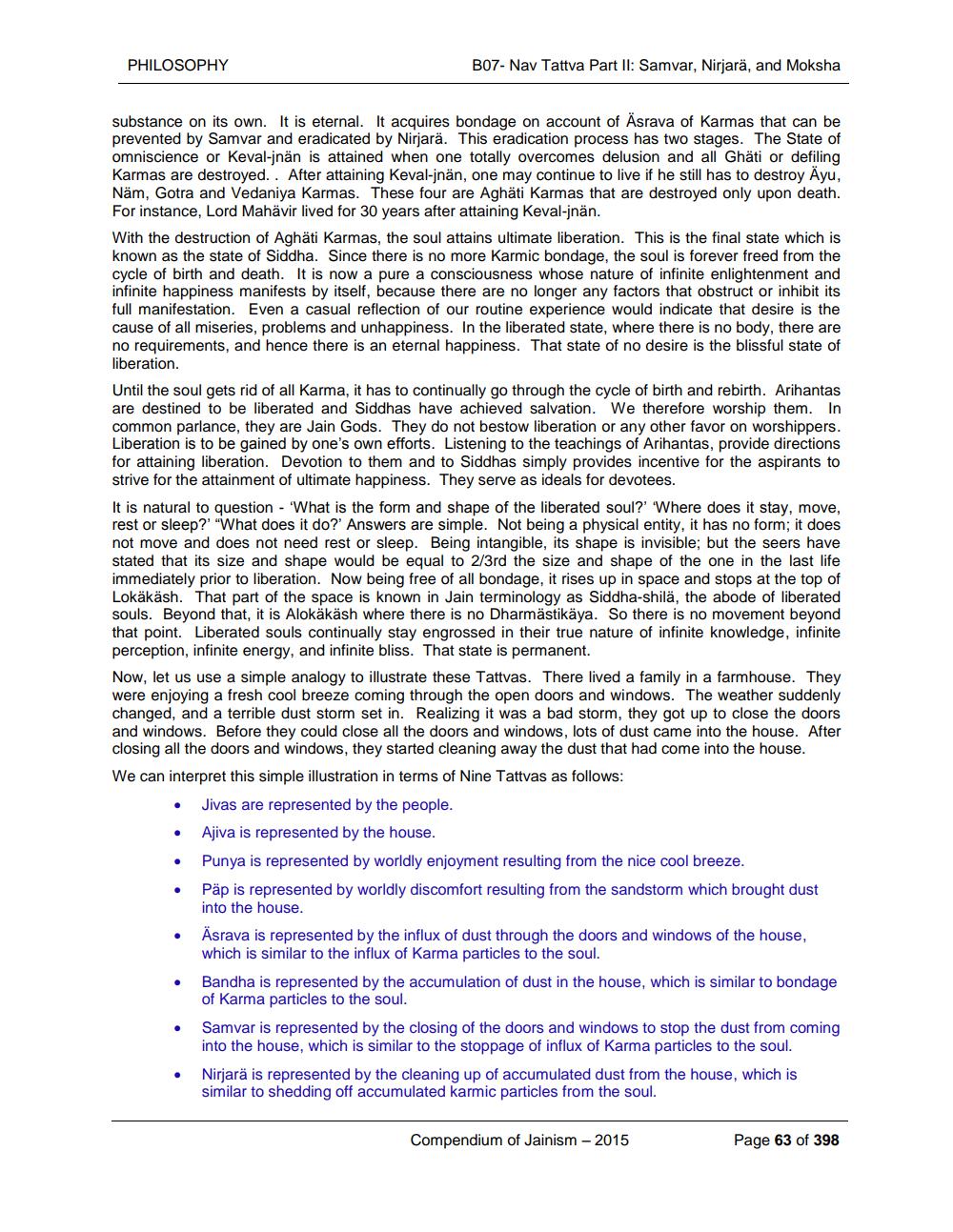________________
PHILOSOPHY
B07- Nav Tattva Part II: Samvar, Nirjarä, and Moksha
substance on its own. It is eternal. It acquires bondage on account of Asrava of Karmas that can be prevented by Samvar and eradicated by Nirjarä. This eradication process has two stages. The State of omniscience or Keval-inän is attained when one totally overcomes delusion and all Ghäti or defiling Karmas are destroyed.. After attaining Keval-jnän, one may continue to live if he still has to destroy Ayu, Näm, Gotra and Vedaniya Karmas. These four are Aghäti Karmas that are destroyed only upon death. For instance, Lord Mahavir lived for 30 years after attaining Keval-jnän. With the destruction of Aghäti Karmas, the soul attains ultimate liberation. This is the final state which is known as the state of Siddha. Since there is no more Karmic bondage, the soul is forever freed from the cycle of birth and death. It is now a pure a consciousness whose nature of infinite enlightenment and infinite happiness manifests by itself, because there are no longer any factors that obstruct or inhibit its full manifestation. Even a casual reflection of our routine experience would indicate that desire is the cause of all miseries, problems and unhappiness. In the liberated state, where there is no body, there are no requirements, and hence there is an eternal happiness. That state of no desire is the blissful state of liberation. Until the soul gets rid of all Karma, it has to continually go through the cycle of birth and rebirth. Arihantas are destined to be liberated and Siddhas have achieved salvation. We therefore worship them. In common parlance, they are Jain Gods. They do not bestow liberation or any other favor on worshippers. Liberation is to be gained by one's own efforts. Listening to the teachings of Arihantas, provide directions for attaining liberation. Devotion to them and to Siddhas simply provides incentive for the aspirants to strive for the attainment of ultimate happiness. They serve as ideals for devotees. It is natural to question - "What is the form and shape of the liberated soul?' 'Where does it stay, move, rest or sleep?' "What does it do?' Answers are simple. Not being a physical entity, it has no form; it does not move and does not need rest or sleep. Being intangible, its shape is invisible, but the seers have stated that its size and shape would be equal to 2/3rd the size and shape of the one in the last life immediately prior to liberation. Now being free of all bondage, it rises up in space and stops at the top of Lokäkäsh. That part of the space is known in Jain terminology as Siddha-shilä, the abode of liberated souls. Beyond that, it is Alokäkäsh where there is no Dharmästikäya. So there is no movement beyond that point. Liberated souls continually stay engrossed in their true nature of infinite knowledge, infinite perception, infinite energy, and infinite bliss. That state is permanent. Now, let us use a simple analogy to illustrate these Tattvas. There lived a family in a farmhouse. They were enjoying a fresh cool breeze coming through the open doors and windows. The weather suddenly changed, and a terrible dust storm set in. Realizing it was a bad storm, they got up to close the doors and windows. Before they could close all the doors and windows, lots of dust came into the house. After closing all the doors and windows, they started cleaning away the dust that had come into the house. We can interpret this simple illustration in terms of Nine Tattvas as follows:
Jivas are represented by the people. • Ajiva is represented by the house.
Punya is represented by worldly enjoyment resulting from the nice cool breeze. Päp is represented by worldly discomfort resulting from the sandstorm which brought dust into the house.
Asrava is represented by the influx of dust through the doors and windows of the house, which is similar to the influx of Karma particles to the soul. Bandha is represented by the accumulation of dust in the house, which is similar to bondage of Karma particles to the soul.
Samvar is represented by the closing of the doors and windows to stop the dust from coming into the house, which is similar to the stoppage of influx of Karma particles to the soul. Nirjarä is represented by the cleaning up of accumulated dust from the house, which is similar to shedding off accumulated karmic particles from the soul.
Compendium of Jainism - 2015
Page 63 of 398




